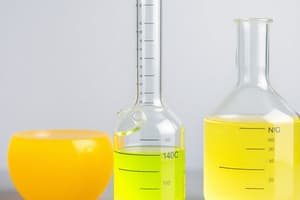Podcast
Questions and Answers
What produces H+ ions in solution according to the Arrhenius definition?
What produces H+ ions in solution according to the Arrhenius definition?
- Water
- Salt
- Base
- Acid (correct)
What are the common formulas of bases?
What are the common formulas of bases?
NaOH, KOH, Ca(OH)2
A base produces H+ ions in solution.
A base produces H+ ions in solution.
False (B)
Which of the following is an example of a strong acid?
Which of the following is an example of a strong acid?
What is the conjugate base of HCl?
What is the conjugate base of HCl?
Stronger acids have stronger conjugate bases.
Stronger acids have stronger conjugate bases.
What defines a monoprotic acid?
What defines a monoprotic acid?
H2SO4 (aq) + H2O (l) -> __________ + HSO4^-
H2SO4 (aq) + H2O (l) -> __________ + HSO4^-
Which of the following is a property of weak acids?
Which of the following is a property of weak acids?
The term for acids with more than one ionizable hydrogen is __________ acid.
The term for acids with more than one ionizable hydrogen is __________ acid.
What is the strength comparison of HClO3 and HBrO3 based on electronegativity?
What is the strength comparison of HClO3 and HBrO3 based on electronegativity?
Flashcards are hidden until you start studying
Study Notes
Arrhenius Definition of Acids and Bases
- An Arrhenius acid produces H+ ions in solution.
- Common acids start with "H" in their formula.
- An Arrhenius base produces OH- ions in solution.
- Metal hydroxides are common bases: examples include NaOH, KOH, and Ca(OH)2.
Bronsted-Lowry Definition of Acids and Bases
- An acid is a proton (H+) donor.
- A base is a proton (H+) acceptor.
- Example: In the reaction HCl + NH3 → NH4+ + Cl-, HCl is the acid, NH3 is the base, NH4+ is the conjugate acid, and Cl- is the conjugate base.
Lewis Definition of Acids and Bases
- A Lewis acid is an electron pair acceptor.
- A Lewis base is an electron pair donor.
Strong Acids and Weak Acids
- Strong acids completely dissociate in solutions, behaving as strong electrolytes.
- Weak acids only partially dissociate, meaning they exist in equilibrium between the undissociated acid form and its ions.
- Strong acids include perchloric acid (HClO4), hydrochloric acid (HCl), sulfuric acid (H2SO4), and nitric acid (HNO3).
- Weak acids include carbonic acid (H2CO3), hydrocyanic acid (HCN), and hydrofluoric acid (HF).
Strong Bases and Weak Bases
- Strong bases include lithium hydroxide (LiOH), sodium hydroxide (NaOH), and potassium hydroxide (KOH)
- Other metal hydroxides, like Al(OH)3 and Mg(OH)2, classify as weak bases.
- Ammonia (NH3) and its derivatives are weak bases.
Binary Acids
- Contain acidic hydrogens attached to a nonmetal ion.
- Examples: HCl, HF.
- Their strength depends on the electronegativity of the nonmetal and the bond strength.
- For elements in the same group (F, Cl, Br, I), the strength increases down the group due to weaker bond strength.
- For elements in the same row, the strength increases with increasing electronegativity.
Oxy-Acids
- Contain acidic hydrogens attached to a nonmetal ion and an oxygen atom.
- Their general formula is H-O-Y, where "Y" is the nonmetal.
- The strength of oxy-acids depends on the electronegativity of Y.
- Greater electronegativity of Y correlates to a stronger acid.
Conjugate Bases
- Stronger acids have weaker conjugate bases (C-bases).
- Weaker acids have stronger conjugate bases.
Monoprotic and Polyprotic Acids
- Monoprotic acids release one proton (H+) per molecule.
- Polyprotic acids release more than one proton per molecule.
- Diprotic acids release two protons (H+).
- Triprotic acids release three protons (H+).
- In polyprotic acids, the first hydrogen ion is ionized easier than the second. For example, H2SO4 is a stronger acid than HSO4-.
Polyprotic Acid Example: Sulfuric Acid (H2SO4)
- First ionization: H2SO4 (aq) + H2O(l) -> (H3O+) + HSO4^-
- Second ionization: HSO4 (aq) + H2O(l) -> (H3O+) + SO4^2-
- The first hydrogen ion in sulfuric acid ionizes more easily than the second, making H2SO4 a stronger acid than HSO4-.
Studying That Suits You
Use AI to generate personalized quizzes and flashcards to suit your learning preferences.




